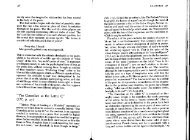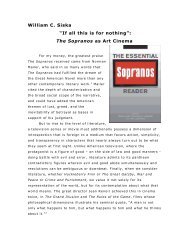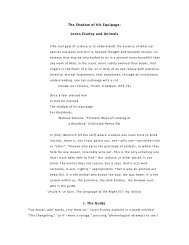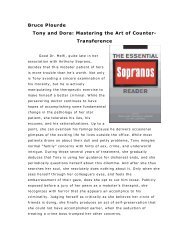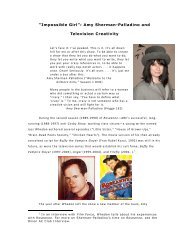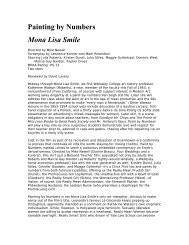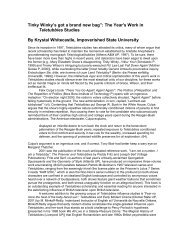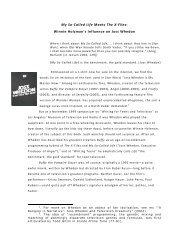Californication and Cultural Imperialism Baywatch ... - David Lavery
Californication and Cultural Imperialism Baywatch ... - David Lavery
Californication and Cultural Imperialism Baywatch ... - David Lavery
You also want an ePaper? Increase the reach of your titles
YUMPU automatically turns print PDFs into web optimized ePapers that Google loves.
<br />
<br />
<br />
<strong>Californication</strong> <strong>and</strong> <strong>Cultural</strong> <strong>Imperialism</strong> <strong>Baywatch</strong> <strong>and</strong> the Creation of <br />
World Culture. Ed. Andrew Anglophone. Point Sur: Malibu University <br />
Reviewed by <strong>David</strong> <strong>Lavery</strong>, Middle <br />
Tennessee State University <br />
We live in the age of the Los <br />
Angelization of Planet Earth. <br />
William Irwin Thompson <br />
Press, 1997. <br />
The television series <strong>Baywatch</strong> premiered in <br />
1990 on NBC <strong>and</strong> was cancelled due to poor <br />
ratings. Resurrected in 1992 as an <br />
independent, non‐network production of All <br />
American Television, the series then <br />
became in world wide syndication, the most <br />
popular show in the history of the medium, <br />
currently attracting approximately 1 billion <br />
viewers in hundreds of countries around the <br />
globe. <br />
Andrew Anglophone of the University of Northern South Dakota at Hoople has <br />
put together a collection of discerning essays for Malibu University Press entitled <br />
<strong>Californication</strong> <strong>and</strong> <strong>Cultural</strong> <strong>Imperialism</strong>: <strong>Baywatch</strong> <strong>and</strong> the Creation of World <br />
Culture. No doubt some will question the need for a scholarly book on such a series. <br />
Indeed, it would be almost tempting to read the essays in Anglophone’s volume—<br />
applications of sophisticated <strong>and</strong> often abstruse au courant methodologies to a very <br />
low culture phenomenon—as quasi‐parodies of television criticism <strong>and</strong> cultural <br />
studies, which is, for this reviewer at least, not to condemn them or doubt their <br />
value. <br />
Anglophone’s own introduction. “America Makes All the Images: <strong>Baywatch</strong> as <br />
a Semiotic Export,” takes its title from Wim Wenders’ Tokyo‐Ga, a documentary <br />
tribute to the great Japanese auteur Ozu. During a visit to a television assembly line, <br />
the German expatriate filmmaker, having just finished a long sojourn in the United
The Collected Works of <strong>David</strong> <strong>Lavery</strong> 2<br />
States, muses on Japan’s dominance of the industry. “The Japanese,” he observes, <br />
“make all the TVs, but the Americans make all the images.” With its tremendous <br />
international popularity, <strong>Baywatch</strong> has obviously contributed mightily to keeping <br />
America in the black in the cultural exchange economy, <strong>and</strong> it is for this reason, <br />
Anglophone argues, that it is worthy of serious consideration. Anglophone would like <br />
his book to st<strong>and</strong> as a contribution to the study of cultural imperialism, the <br />
hegemonic colonization under world capitalism of other cultures by dominant <br />
cultures like that of the United States. (It is to this coercive signifying supremacy <br />
that “the <strong>Californication</strong>” of his title refers.) To some extent he succeeds. <br />
The title of the book, which suggests a strongly neo‐Marxist approach, a <br />
cultural studies consideration of <strong>Baywatch</strong> as a prime case of Jameson’s “late <br />
capitalism” at work, is in a sense misleading. Although it does indeed consider the <br />
series in an international context, it does much more as well, offering a variety of <br />
approaches to <strong>Baywatch</strong> both as text <strong>and</strong> cultural/economic phenomenon. Allow me <br />
to offer a brief guided tour, surfing over the book’s deep waters <strong>and</strong> navigating <br />
carefully its shallows. <br />
The author of an earlier book on The Case of California, a collection of <br />
psychoanalytic meditations on everything Californian, from fast food to Valley Girls, <br />
Lawrence A. Rickels, Professor of German at UC Santa Barbara, uses his essay, “Tan <br />
Lines <strong>and</strong> Identity: A Psychohistorical Reading of <strong>Baywatch</strong>,” to examine <strong>Baywatch</strong>’s <br />
cultural moment. Just as Erik Erikson wanted to underst<strong>and</strong>, in Young Man Luther, <br />
why the Reformation happened when it did, what factors in history’s developmental <br />
psychology produced Martin Luther when <strong>and</strong> where it did, Rickels seeks to ascertain <br />
the why <strong>and</strong> wherefore of <strong>Baywatch</strong>. Why did the 1990s need <br />
this show? To what in our unconscious does it speak? <br />
In “Surf <strong>and</strong> Simulation: Baudrillard <strong>and</strong> <strong>Baywatch</strong>,” <br />
Marc Kipness adopts some of the ideas of the French <br />
philosopher of communication, especially those expressed in <br />
Baudrillard’s two travel books about the United States, <br />
America <strong>and</strong> Cool Memories, in order to assess the cultural <br />
significance of <strong>Baywatch</strong>. California, writes Baudrillard, a PoMo de Tocqueville, is <br />
"the world center of the inauthentic.” Kipness’ intent is to trace the dissemination of <br />
this inauthenticity—to show how <strong>and</strong> why <strong>Baywatch</strong> has captured the world’s <br />
imagination. <strong>Baywatch</strong>’s historical moment, Kipness argues, arrived at a time of <br />
cultural AIDS, to use Baudrillard’s frightening metaphor:
<br />
<br />
The Collected Works of <strong>David</strong> <strong>Lavery</strong> 3<br />
We don't have anything to oppose to [American] cultural contamination. <br />
<strong>Cultural</strong>ly <strong>and</strong> philosophically exhausted, we remain unable to transform our <br />
past into living values for the present. Our cultural antibodies have acquired <br />
an immune deficiency <strong>and</strong> can't resist the virus. <br />
Baudrillard’s “we” refers, of course, to Europe <strong>and</strong> Europeans generally; but Kipness <br />
universalizes the insight: <strong>Baywatch</strong>’s “hardbodies,” his essay demonstrates, triumph <br />
with ease over the defenseless antibodies of other cultures, from east to west. <br />
Drawing on the still‐suggestive insights of Laura Mulvey, Linda Brigance takes <br />
a close look at <strong>Baywatch</strong>’s televisual style. Focusing on its opening credit sequence <br />
<strong>and</strong> then on the series’ first episode, the classic “Panic at Malibu Pier,” Brigance’s “T <br />
<strong>and</strong> A: Gazing <strong>Baywatch</strong>” provides not only a discerning analysis of the show’s gender <br />
address but a suggestive thesis on the place of anatomy in the postmodern <br />
imagination. Especially illuminating is her brief history of TV T & A, from Charlie’s <br />
Angels to <strong>Baywatch</strong>. <br />
Brigance’s essay foregrounds Pamela Anderson, the plasticized bimbo who has <br />
turned on a large percentage of <strong>Baywatch</strong>’s avid world‐wide following. In her piece <br />
on “<strong>David</strong> Hasselhoff: A Semiotic Approach to One of the World’s Most Recognized <br />
Images,” Diane Stevenson investigates the appeal of the series’ real star. One of the <br />
best known individuals on the face of the earth (Stevenson ranks him right up there <br />
with Michael Jackson, Schwarzenegger, Bill Clinton), Hasselhoff has parleyed minor <br />
success in the soap opera Young <strong>and</strong> the Restless <strong>and</strong> modest US ratings for his series <br />
Knightrider, in which he played second banana to a talking car, into the tremendous <br />
world‐wide international popularity of Knightrider <strong>and</strong> then into the megahit of <br />
<strong>Baywatch</strong>. Hasselhoff’s popularity does not stop there, of course: overseas, <br />
especially in Europe, he is a music superstar as well, a second Elvis, a performer <br />
whose recordings all go megaplatinum <strong>and</strong> who was, for example, a featured <br />
performer at the concert that marked the dismantling of the Berlin Wall. A careful <br />
look at Hasselhoff’s physical signifiers—height, age, tight buns, wavy hair, chest hair, <br />
voice—<strong>and</strong> at his character, Mitch Buchanon, on <strong>Baywatch</strong> (Mitch’s status as a single <br />
father in the ‘90s attracts special attention from Stevenson) leads to a surprising <br />
thesis concerning Hasselhoff’s signifieds. <br />
Br<strong>and</strong>on Tartikoff tells the story of NBC’s at first futile attempts to sell <br />
Laverne <strong>and</strong> Shirley into European syndication. After several failed attempts to
The Collected Works of <strong>David</strong> <strong>Lavery</strong> 4<br />
interest EC networks in the show, NBC remarketed the series with a frame tale <br />
added. Laverne <strong>and</strong> Shirley were reconceptualized as runaways from a mental <br />
hospital, an escape depicted in a newly added opening sequence, <strong>and</strong> the show <br />
caught on. <strong>Baywatch</strong> needed no such repackaging. But the history of its marketing—<br />
through ads, cds, commodity intertexts, music, World Wide Web sites—is not without <br />
interest. In “<strong>Baywatch</strong> as Commodity: Marketing the World’s Most Popular Show,” <br />
Dick Campbell, author of an excellent book on 60 Minutes, catalogues more than we <br />
would ever want to know about the packaging of <strong>Baywatch</strong> <strong>and</strong>, in the process, has <br />
more than a little to say about how America’s entertainment taste has become the <br />
world’s taste. <br />
Like Kipness, K. Kalinak draws on Baudrillard’s America for her key insight in <br />
an essay on <strong>Baywatch</strong>’s music. It is an obscure comment on television laugh tracks <br />
which catches her attention: <br />
<br />
<br />
Laughter on American television has taken the place of the chorus in Greek <br />
tragedy. It is unrelenting; the news, the stock exchange reports, <strong>and</strong> the <br />
weather forecast are about the only things spared. But so obsessive is it that <br />
you go on hearing it behind the voice of Reagan or the Marines disaster in <br />
Beirut. Even behind the adverts. It is the monster from Alien prowling around <br />
in all the corridors of the spaceship. it is the sarcastic exhiliration of a <br />
puritan culture. In other countries the business of laughing is left to the <br />
viewers. here, their laughter is put on the screen, integrated into the show. It <br />
is the screen that is laughing <strong>and</strong> having a good time. You are simply left <br />
alone with your consternation. <br />
Kalinak’s “Surf <strong>and</strong> Sufeit: The Role of Music in <strong>Baywatch</strong>” treats the series’ <br />
pounding, overbearing, annoying, awful music as equally manipulative <strong>and</strong> “alien.” <br />
The author of a seminal earlier study on the cross‐cultural impact of Dallas, <br />
Tamar Liebes of Hebrew University in Jerusalem sets out here to applied a similar <br />
methodology to <strong>Baywatch</strong>. “Decoding <strong>Baywatch</strong>: A Cross‐<strong>Cultural</strong>, Ethnographic <br />
Study” uses interviews with fifty informants in ten countries (including Saudi Arabia, <br />
Israel, India, <strong>and</strong> Japan) in order to ascertain the various ways in which the series is <br />
actually used in different cultural contexts. The result is somewhat surprising <strong>and</strong> at <br />
least partially mitigates the argument that a series like <strong>Baywatch</strong> necessarily feeds <br />
the tendency toward monoculture.
The Collected Works of <strong>David</strong> <strong>Lavery</strong> 5<br />
Michael Dunne’s “Bakhtin Goes to the Beach: Dialogism <strong>and</strong> <strong>Baywatch</strong>” is <br />
likewise less harsh in its criticism of the series. Drawing on Horace Newcomb’s <br />
adoption of Bakhtinian notions in his depiction of the dialogic “cultural forum” <br />
offered by television, Dunne suggests that <strong>Baywatch</strong> is not as monological as it might <br />
appear, that indeed it speaks with many voices representing many constituencies <strong>and</strong> <br />
seeks to be, in its own stupid way, as politically correct as possible for a T <strong>and</strong> A <br />
show. <br />
Elizabeth Kubek’s deep but illuminating “Mirrors of S<strong>and</strong>: <strong>Baywatch</strong> from a <br />
Lacanian Perspective” is perhaps the toughest essay in Anglophone’s book, using as it <br />
does the French Freud’s difficult psychoanalytic approach to study what she calls <br />
“the problematics of patriarchy” as explored in <strong>Baywatch</strong>. Taking as her subject “the <br />
relation of paternal or quasi‐paternal authority to ‘truth,’” a theme explored in the <br />
desire for belief, knowledge, <strong>and</strong> validation of its central characters, Kubek zeros in <br />
on the uncertain relationship of single father Mitch <strong>and</strong> his teenage son Hobie, a <br />
young man named after a surf board. <br />
With an initial focus on a single <strong>Baywatch</strong> episode (“Now Sit Right Back” in <br />
the second season) in which the lifeguards save (in a dream sequence, of course) the <br />
str<strong>and</strong>ed crew of Gilligan’s Isl<strong>and</strong>, Michael Carroll details—in “Saving Gilligan: Meta‐ <br />
<strong>and</strong> Inter‐Textuality in <strong>Baywatch</strong>”—the series’ prominent references not only to <br />
other shows but to itself. As Carroll demonstrates, <strong>Baywatch</strong> not only incorporates <br />
“real” people into its plots (World Wrestling Federation superstar Hulk Hogan plays <br />
himself in one episode, the Beach Boys <strong>and</strong> gymnast Mary Lou Retton appear in <br />
others), it also incorporates the diegesis of other series. In addition to the episode <br />
cannibalizing Gilligan’s Isl<strong>and</strong>, there are others in which television itself becomes the <br />
subject—the one, for example, in which <strong>Baywatch</strong>’s women find themselves in a <br />
fantasy recreation of Charlie’s Angels. <br />
Other examples of inter‐ <strong>and</strong> metatextuality abound, as Carroll shows. In <br />
“Game of Chance” the <strong>Baywatch</strong> crew captures a specially designed recreational <br />
vehicle which has been used in a series of robberies—a car capable of instant <br />
conversion into a boat. At the show’s end, as Mitch inspects the vehicle <strong>and</strong> its <br />
capabilities (four wheel drive, a great stereo system) are listed, he asks, apropos of <br />
nothing at all, “Does it talk?” When told that it does not, he insists, with a wink at <br />
the camera, that he is not interested in it. The wink, Carroll notes, is intertextual: a <br />
reference to <strong>David</strong> Hasselhoff’s talking car in his former series, Knightrider. In other <br />
highly metatextual episodes, <strong>Baywatch</strong> seems to have become as self‐conscious as
The Collected Works of <strong>David</strong> <strong>Lavery</strong> 6<br />
any another work of high postmodernism. In “Beauty <strong>and</strong> the Beast,” for example, <br />
the series plays off of its own reputation as a showcase for the physical attributes of <br />
Pamela Anderson <strong>and</strong> others as Inside Sports magazine comes to <strong>Baywatch</strong> in search <br />
of a lifeguard model for its swimsuit issue. And in “Rescue Bay,” for example, a <br />
sleazy television producer decides to create a new series based on the adventures of <br />
a group of California lifeguards <strong>and</strong> casts several <strong>Baywatch</strong> members in the show. (He <br />
finally decides not to do the series because no one could possibly be interested in a <br />
show about lifeguards.) <strong>Baywatch</strong>’s allusionary nature, Kipness argues, its hyper‐<br />
awareness of what Eco has deemed “the already said,” thus make it essentially a <br />
postmodern text, though admittedly an unlikely one. <br />
That television is a “producers medium” is a truism of television studies. Very <br />
little attention has been paid to either the directors or the writers of TV, who remain <br />
almost completely invisible <strong>and</strong> unacknowledged. Carol Marton’s “Deborah Schwartz: <br />
A <strong>Baywatch</strong> Auteur” makes an effort to fill this void by examining the eighteen <br />
episodes of the series written by Deborah Schwartz. Scrutinzing the key themes, <br />
plots, characters, <strong>and</strong> images of Schwartz’s teleplays, Marton wrestles with the large <br />
question of how an individual voice <strong>and</strong> vision find the means of self expression <br />
within the flow of an ongoing, highly formulaic series. <br />
In “Bash at the Beach,” from <strong>Baywatch</strong>’s 4th Season. C.J. saves the life of <br />
wrestler Hulk Hogan. In her debt, he agrees to wrestle his nemesis Rick Flair for the <br />
Heavyweight Championship as a fund‐raiser to save the Venice Beach Boys’ Club. <br />
Needless to say, this episode attracts the attention of James Baker of Texas A & M <br />
University in “<strong>Baywatch</strong> <strong>and</strong> Television Wrestling: A Narratological Comparison.” But <br />
Baker is interested in much more than this overt inclusion of professional wrestling <br />
into the text of <strong>Baywatch</strong>. Baker’s ingenious essay offers a surprising comparison <strong>and</strong> <br />
contrast of <strong>Baywatch</strong>’s multiple‐episode, ongoing plots with the yearly metaplot of a <br />
professional wrestling season. Baker find in both the same kind of good guys <strong>and</strong> bad <br />
guys, the same plots, the same human interests, the same conflicts, the same clichés. <br />
Baker finds correspondences between <strong>Baywatch</strong> <strong>and</strong> the “genre” of <br />
Professional Wrestling; Karen Basore traces all sorts of other genre signatures in her <br />
essay “All Things to All People: The Question of <strong>Baywatch</strong>’s Genre.” As Basore shows, <br />
<strong>Baywatch</strong> is in one sense only a “recombinant” (the term is Todd Gitlin’s) warmed‐<br />
over, hybridization of Sea Hunt <strong>and</strong> C.H.I.P.S., its chief Bloomian ancestor texts. <br />
(Basore begins her essay with an hilarious reconstruction of the quintessential “all <br />
things to all people” C.H.I.P.S. episode, in which Jon Baker <strong>and</strong> Ponch Poncherello
The Collected Works of <strong>David</strong> <strong>Lavery</strong> 7<br />
not only get their man in an exciting, ridiculously overscored motorcycle chase scene <br />
but win a disco contest during which they also manage to deliver a baby!) <strong>Baywatch</strong>, <br />
Basore shows, owes much as well to other television forms: to the soap opera (for its <br />
multiple story lines), to sitcoms (for its attempted humor), to disease‐of‐the‐week <br />
movies (for its frequent tackling of topical subjects), to MTV videos (for its music <br />
montages), to cop shows (for its increasing interest in crime solving—a plot element <br />
which led eventually to <strong>Baywatch</strong> Nights, a spin‐off show in which Mitch Buchanon <br />
moonlights as a private detective), to sun screen commercials <strong>and</strong> other <br />
advertisements (for its overall visual style). <br />
Janice Rushing <strong>and</strong> Tom Frentz of the University of Arkansas, author of <br />
discerning analyses of “public discourse” in cultural phenomenon from Reagan’s <br />
“Star Wars” address to E. T., turns her skills as an analyst of mediated rhetoric to <br />
<strong>Baywatch</strong> in “Amoral Moralism: <strong>Baywatch</strong>, Public Discourse, <strong>and</strong> the Didactic Text.” <br />
What interests Rushing <strong>and</strong> Frentz most is the series’ almost sermonish nature. <br />
<strong>Baywatch</strong>, she shows, is not all T <strong>and</strong> A, s<strong>and</strong> <strong>and</strong> surf, ski‐doos <strong>and</strong> jet skiis: episode <br />
after episode deals with subjects of a topical, indeed public service nature: AIDS, <br />
attention‐deficit disorder, oil spills, injured animals, gangs, Native American rights, <br />
the special olympics, retinitis pigmentosa, funding for youth centers, teen <br />
alcoholism, Alzheimer’s disease, obesity, designer drugs, homelessness, sexual <br />
harassment, adoption, single fathering, custody battles—all make their appearance <br />
on <strong>Baywatch</strong>. Rushing <strong>and</strong> Frentz find especially interesting an episode called <br />
“Desperate Encounter,” described on <strong>Baywatch</strong>’s own World Wide Web site as “a <br />
ground‐breaking episode on the gruesome fate of unwanted horses in America.” <br />
In “The Postmodern Inane: <strong>Baywatch</strong> <strong>and</strong> the Insipid,” J. P. Telotte of the <br />
Georgia Institute of Technology, wrestles with the profound question of the series’ <br />
essential vacuity. How could such a derivative, formulaic, unimaginative series <br />
become such a world‐wide phenomenon? <strong>Baywatch</strong>’s inanity, Telotte suggests, is not <br />
a critic’s discovery; the series itself knows, as its meta‐ <strong>and</strong> intertextuality reveal, <br />
that it is stupid, <strong>and</strong> this self‐awareness should be understood, according to Telotte, <br />
as yet another sign of what Mark Crispin Miller has called contemporary television’s <br />
“deride <strong>and</strong> conquer” strategy, its tendency to make fun of itself before its audience <br />
has the chance to, to acknowledge that its own badness is no excuse for hitting the <br />
remote button. <br />
In several recent venues, Miller, himself the author of the book’s final essay, <br />
has commented on the ironic history of the early movie era dream that the advent of
The Collected Works of <strong>David</strong> <strong>Lavery</strong> 8<br />
film might lead to a common, indeed a universal, language. This dream, which, as <br />
Miller shows, was rife among the medium’s founding fathers, has now been realized. <br />
The whole world is now hooked on the Hollywood text; from Kuala Lampur to Buenos <br />
Aires, world citizens speak fluent Schwarzenegger; they are conversant in American <br />
genres, American action‐adventure / dolbyized / MTV edited cinematics; their <br />
fluency, in fact, has made them largely uninterested in learning any other language. <br />
The Esperanto of the American movie export has carried the day. Such is Miller’s <br />
thesis. In his essay in Anglophone’s volume, “The Los Angelization of Planet Earth: <br />
<strong>Baywatch</strong> <strong>and</strong> the Dream of a Common Language,” Miller examines <strong>Baywatch</strong>’s <br />
influential role in this linguistic dispersal. What exactly will it mean for the future of <br />
consciousness, Miller wants to know, that 1 billion people worldwide internalize <br />
<strong>Baywatch</strong>’s weltanschauung? on a weekly basis. “We live in the age of the Los <br />
Angelization of Planet Earth,” cultural historian William Irwin Thompson has <br />
argued—a line that inspired Miller’s title. <strong>Baywatch</strong> Los Angelizes with a vengeance. <br />
<br />
Did not the novelist Philip Roth predict back in the 1960s that by <br />
century’s end the front page of the New York Times would be <br />
indistinguishable from satire? It should not surprise us that in the <br />
age of the death of irony the real thing <strong>and</strong> the parody of it have <br />
merged. Andrew Anglophone’s book on <strong>Baywatch</strong> epitomizes this <br />
merger, an amalgamation as natural as ABC <strong>and</strong> Disney. <br />
<br />
Works Cited <br />
Baudrillard, Jean. America. Trans. Chris Turner. London: Verso, 1989 <br />
___. Cool Memories. Trans. Chris Turner. London: Verso, 1990. <br />
Campbell, Dick. Sixty Minutes. Urbana: University of Illinois Press, 1993. <br />
Miller, Mark Crispin. “Deride <strong>and</strong> Conquer.” In Watching Television. A Pantheon <br />
Guide to Popular Culture. ed. Todd Gitlin. NY: Pantheon: 1987. 183‐228. <br />
Newcomb, Horace <strong>and</strong> Paul M. Hirsch. “Television as a <strong>Cultural</strong> Forum.” Television: <br />
The Critical View, 4th Edition. Ed. Horace Newcomb. New York: Oxford <br />
University Press, 1987. 455‐70. <br />
Rickels, Lawrence. The Case of California. Baltimore: Johns Hopkins University Press, <br />
1991. <br />
Thompson, William Irwin. At the Edge of History: Speculations on the Transformation <br />
of Culture. NY: Harper <strong>and</strong> Row, 1971.
The Collected Works of <strong>David</strong> <strong>Lavery</strong> 9<br />
Tomlinson, John. <strong>Cultural</strong> <strong>Imperialism</strong>. Baltimore: Johns Hopkins University Press, <br />
1991.





